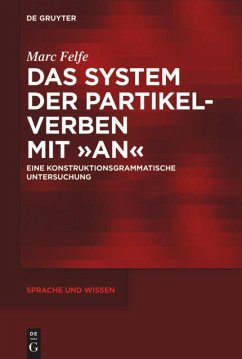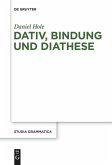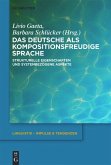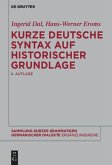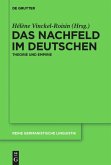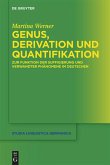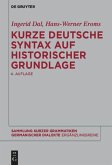Approximately fifty percent of the form and the meaning of transparent German particle verbs with â??anâ? can be deduced from the minimal semantic argument structure of the verb and particle. The aim of this study is to create a format for understanding the remaining fifty percent using construction grammar analysis. The study employs frame semantics to explain the compositionality of the verb and the construction. The system is based on a flexible schema-instance relationship, where instances are the prototypes for schemata.
Für produktive Bildungen und für bestehende transparente sowie nicht bzw. teiltransparente Partikelverben mit "an" wird ein Analyseformat erarbeitet. Komplexe Argumentstrukturen werden als mehr oder weniger selbstständige und mehr oder weniger schematische Konstruktionen, das heißt Einheiten aus Form und Funktion, analysiert. Die Partikel "an" ist lexikalischer Bestandteil der Konstruktionen. Die Reihenfolge und Kasusmarkierung der Argumentstellen bilden die formale Seite. Die Bedeutungsseite wird in Form von Ereignistypen beschrieben, welche Instanzen von semantischen Frames sind. Das Zusammenspiel zwischen Verben und Argumentkonstruktionen wird als Profilierung und Perspektivierung zentraler oder peripherer Werte des verbalen Frames innerhalb der von den Argumentkonstruktionen ausgedrückten Ereignistypen beschrieben. Kompositionalität ist das wesentliche Prinzip sprachlicher Strukturbildung. Es beruht jedoch nicht auf Berechnung statischer Minimalwerte, sondern einem prozessualen Ein- und Ausblenden sowie Überführen frame-semantischer Werte zwischen Verb und Konstruktion. Das System der Partikelverben mit "an" wird als Netz von Familienähnlichkeiten und flexiblen Schema-Instanz-Beziehungen dargestellt.
Für produktive Bildungen und für bestehende transparente sowie nicht bzw. teiltransparente Partikelverben mit "an" wird ein Analyseformat erarbeitet. Komplexe Argumentstrukturen werden als mehr oder weniger selbstständige und mehr oder weniger schematische Konstruktionen, das heißt Einheiten aus Form und Funktion, analysiert. Die Partikel "an" ist lexikalischer Bestandteil der Konstruktionen. Die Reihenfolge und Kasusmarkierung der Argumentstellen bilden die formale Seite. Die Bedeutungsseite wird in Form von Ereignistypen beschrieben, welche Instanzen von semantischen Frames sind. Das Zusammenspiel zwischen Verben und Argumentkonstruktionen wird als Profilierung und Perspektivierung zentraler oder peripherer Werte des verbalen Frames innerhalb der von den Argumentkonstruktionen ausgedrückten Ereignistypen beschrieben. Kompositionalität ist das wesentliche Prinzip sprachlicher Strukturbildung. Es beruht jedoch nicht auf Berechnung statischer Minimalwerte, sondern einem prozessualen Ein- und Ausblenden sowie Überführen frame-semantischer Werte zwischen Verb und Konstruktion. Das System der Partikelverben mit "an" wird als Netz von Familienähnlichkeiten und flexiblen Schema-Instanz-Beziehungen dargestellt.

